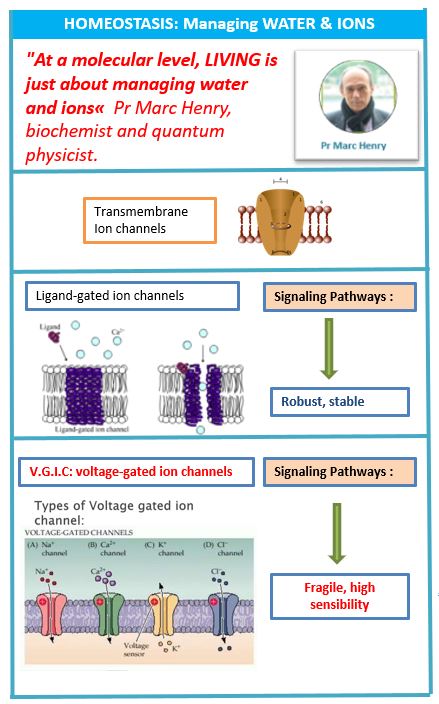Homeostasis : Life is about managing water & ions

Pr Marc Henry concludes his conference with this statement: “In fact, life is just about managing water and ions !
Why such a statement? The answer is simple: to qualify a state of healthy balance, the criteria is your HOMEOSTASIS: most of your biological functions are orchestrated by the appropriate distribution of main ions in the intracellular and extracellular fluids.
Ion Homeostasis
Ion channels are pore-forming membrane proteins that are present in the membranes of all cells. The main function of ion channels is the maintenance of ion gradients across the cell membrane, shaping action potentials and other electrical signals, controlling the ion flow across secretary and epithelial cells, and regulating the cell volume. Ion channels play a critical role in physiology and many different biological processes such as neuronal signal transmission, muscle contraction, or T-cell activation. Dysfunction of ion channels is the cause of several diseases and can lead to cystic fibrosis or improper functioning of the nervous system, to name just a few
Calcium Ion Homeostasis
Calcium channels allow the passage of calcium ions in response to depolarization of the cell membrane. The accumulation of calcium can then regulate the contraction of muscles, trigger the release of neurotransmitters or hormones, modulate intracellular signaling pathways, and impact several other calcium-dependent cellular functions. Calcium channels play an important role in several diseases, such as diseases related to the cardiovascular or nervous systems.
Who are the ions controllers? how do they operate? are they stable, or can they lose control?
The guardians of the “doors” of intracellular ions are of two types: they belong to the family of ION CHANNELS, and there are 2 kinds of transmembrane ion channels:( see picture left):
- Ligand-gated ion channels, that are stable, robust an unaffected by EMF environment. Ligand-gated ion channels are located in the cell membrane. They open for ions to pass after binding of their ligand. Ligand binding results in a structural change to the channel and its permeability. The channel can open and ions are able to pass through. They are very stable.
- Voltage-gated-ion channels that have an extraordinary sensitivity to the smallest voltage changes, and which appear to respond to extremely low frequency fields.

Picture Right : Legend: Voltage-gated ion channels are a class of transmembraneproteins that form ion channels that are activated by changes in the electrical membrane potential near the channel. The membrane potential alters the conformation of the channel proteins, regulating their opening and closings, have a crucial role in excitable cells such as neuronal and muscle tissues, allowing a rapid and coordinated depolarization in response to triggering voltage change.
